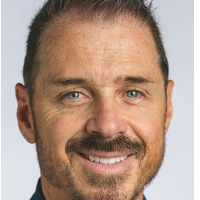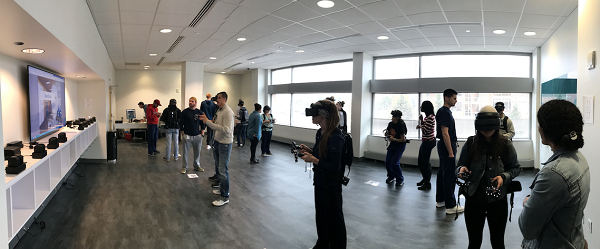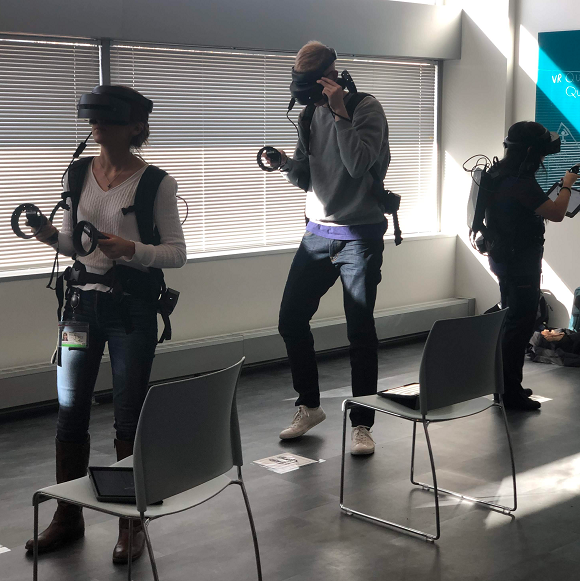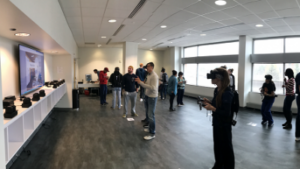While attending the University of Colorado Systems’ spring technology symposium last week, I found myself in a conference session entitled “Shaping the Future of Dental Education Through Extended Reality Systems For Teaching, Training and Assessment” offered by Dr. Tom Greany and Ben Wilkoff from the University of Colorado School of Dental Medicine.

The session showcased how a team of innovators, intent on strengthening their educational program, leveraged digital assets to improve teaching, dental operator skills, and the assessment of student performance. The presentation illuminated the continued importance of modern display technologies in medical education, and most interestingly, helped answer the enduring question: “If you build it, will they come?”
The backdrop.
The project highlighted in this session offered three distinct medical simulation technologies, all using many more modern displays than dental education ever did in traditional classrooms: a VR space, a haptics lab, and a 3D scanning/visualization component.
A veritable locker room of HP Z VR backpacks
The VR space is outfitted with an entire locker room of HP Z VR backpacks. Using these devices, students participate in virtual anatomy lessons offered by the school of dentistry, as well as other experiences. In their virtual experiences, student can record and review their efforts, aiming for iterations with fewer mistakes. See this video of students in action:
The haptics lab solves a problem in traditional dental instruction in which students are taught operation skills using plastic models (that are often a bit incorrect and don’t feel the same) inset in mannequins. The new haptics-enabled displays provide a touch-sensitive experience for students, accurate to what it really feels like to operate on a patient’s teeth. One goal is to learn how to cut a circular path to a specified depth, a make-or-break competency for many students. The lab set up allows students to work at individual stations while mirroring their work to a large screen display for next-up participants.
The 3D scanning/visualization component enables dental students to do repeated virtual operations and what-if analyses/predictions with their virtual treatment. In traditional dentistry classrooms, students studying dental anatomy are required to recreate plastic teeth in wax. Using 3D digital scanners, exact virtual replicas are easily created, used, reused, and student operation skills can be applied with precision. The same displays enable digital grading of wax-up contours by supervising professors with higher accuracy.
The constraints.
Bleeding edge technology is not without its limitations. Ben Wilkoff, project manager for these innovations, anticipated a number of preventable constraints in this. Some of this “problem prevention” planning is worth mentioning here. Wilkoff noted that “we’ve done this with a careful study of the student experience” in mind. With the dedicated VR space, Wilkoff explains, “we use spotters for safety.” This makes a lot of sense, especially in light of a previous Display Daily article I wrote about using the HP Z VR backpacks:
“…the ability to move freely in a classroom space sounds desirable, but is fraught with concerns for those that really understand the classroom. Alarms immediately [go] off in my head with serious concerns for student safety. There is ample evidence across the nation that mobile VR (any attempt at moving around with VR) has frequently resulted in student or teacher injury. (Imagine falling, crashing, colliding, or knocking against hard and unforgiving surfaces.) Mobility is tempting but requires written and clearly understood protocols and classroom safety measures.”
 Dr. Tom Greany, University of ColoradoDr. Greany also lamented about another issue they face: “The user interface hasn’t really caught up to where the apps are; but we are able to teach around the limitations”, he suggested. I hear this from many educators: the kludgy aspects of VR and simulations can include latency, in-experience navigation, intuitiveness, user interface, and gesture control, to name a few. Dr. Greany and the project staff are well aware of the need for workarounds.
Dr. Tom Greany, University of ColoradoDr. Greany also lamented about another issue they face: “The user interface hasn’t really caught up to where the apps are; but we are able to teach around the limitations”, he suggested. I hear this from many educators: the kludgy aspects of VR and simulations can include latency, in-experience navigation, intuitiveness, user interface, and gesture control, to name a few. Dr. Greany and the project staff are well aware of the need for workarounds.
The results.
Both Dr. Greany and Mr. Wilkoff seemed pleased with many of their preliminary results, and they should be. In short, the project leaders have found benefits in the areas of teaching, training, and assessment”. “The visualization is amazing”, they exclaim.
In the haptics lab, they have found that the technology provides:
- students and professors with precise metrics, showing if students are doing operations and skills exactly right
- data on whether student skills are improving over time and given repeated practice
- improvement in faculty assessment (as imprecise visual inspections with low interrater reliability are eliminated)
- potential cost savings (since a cadaver used for simulated operations cannot be reused)
In the scanning/visualization lab, these results were evidenced:
- Time and money investments are reduced (since the 3D model is restorable; mistakes no longer take so much time to re-do or rebuild)
- Students are able to predict critical stress areas (whether a tooth might break) and test their work without penalty of time and reconstructive effort
- Subjective assessment of student performance is replaced by precise mathematical measurement of work and progress
- The time it takes to complete some course requirements can be compressed
In the VR space, student morale has shown improvement, chiefly due to the “noble failure” benefits of learning simulations and time savings.
 The VR space at the School of Dental Medicine, University of Colorado
The VR space at the School of Dental Medicine, University of Colorado
Will they come?
One always wonders how students will ‘take’ to the new technologies placed in front of them. In fact, this is the big story here. The VR experiences were integrated as an extra credit assignment in their required anatomy classes, meaning students were not required to use the HP Z VR backpacks, and they could just complete their course the traditional way. Notably, all 81 students in the dental program signed up for the VR experiences, representing 100% participation. In the first two weeks of the offering, in an effort to review or prepare for critical exams, organizers saw 277 reservations for the VR equipment spread out over 3 sessions of 50 minutes each. Both the haptics lab and the 3D scanning/visualization component also met with positive student reaction in terms of building morale and enabling student success.
Visualization, VR, and 3D are not new to dental education. In the past, I have written articles about the use of these technologies at the University of Tennessee’s Dental School and the Centre for Professional Development in Sydney. The University of Michigan School of Dentistry is also using an app, VR Patient, to offer an immersive surgical simulation to their students and there are also numerous projects underway at the Massachusetts Institute of Technology.

So, if you build it, will they come? In the case of the University of Colorado, when VR or hatics are tied to a grade, yes, they will come. When VR is not required, yet tied to high-stakes dental school assessments, yes, they will come. When VR and haptics are tied to low stakes assessment and permit noble failure while learning, then yes, they will come. –Len Scrogan

